NDVI stands for "Normalized Difference Vegetation Index". NRG stands for "Near-infrared / Red / Green". NDVI and NRG are both ways to visualize the amounts of infrared and other wavelengths of light reflected from vegetation. Because both these methods compare ratios of blue and red light absorbed versus green and IR light reflected, they can be used to evaluate the health of vegetation. It's a snapshot of how much photosynthesis is happening. This is helpful in assessing vegetative health or stress. (Read more here: https://www.agronomy.org/publications/jeq/articles/36/3/832) ## Do-It-Yourself These techniques for vegetation analysis were developed for satellite imagery, but at Public Lab, we've been working a lot on capturing infrared imagery using our DIY [near-infrared camera](/wiki/near-infrared-camera) setup, and combining it with visible bands to produce NDVI images such as the one above. ## What these images mean What exactly are these images we're trying to make? What do they tell us about vegetation, and why? These diagrams should help to understand what it is we're doing and why these are good ways to analyze plant life. ## The NDVI equation [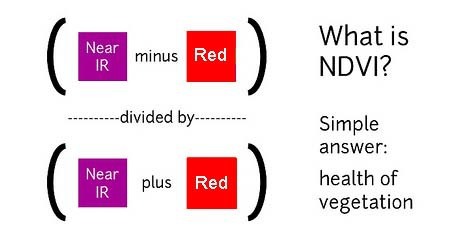](/i/44723) **NDVI = (Near Infrared - Red)/(Near Infrared + Red)** NDVI is a ratio which tries to emphasize photosynthesis while filtering out sun glare. The above equation is run for every pixel, using source data from an infrared photo and a visible light photo, like this pair: [](https://publiclab.org/system/images/photos/000/021/771/original/5390895115_c9d4d38fec_o.jpg) The result can be false-colored to make the high-photosynthesis areas more clear, and used to examine where plants are and how healthy they are. [](https://publiclab.org/system/images/photos/000/021/770/original/PetVISNDVIcomp.png) _Figure above: Normal color photo (right) and normalized difference vegetation index (NDVI) image (left). NDVI image was derived from two color channels in a single photo taken with a camera modified with a special infrared filter. Note that tree trunks, brown grass, and rocks have very low NDVI values because they are not photosynthetic. Healthy plants typically have NDVI values between 0.1 and 0.9. -- @cfastie_ ### Activities Here are a range of activities you can do to produce and interpret your own NDVI imagery, whether downloaded from a satellite imagery provider or [collected yourself using a DIY technique](/wiki/multispectral-imaging) [activities:ndvi] ****   Most DIY converted cameras today (those from Public Lab) use RGN instead of NRG, so the blue channel represents infrared instead of the red channel. That looks like this: [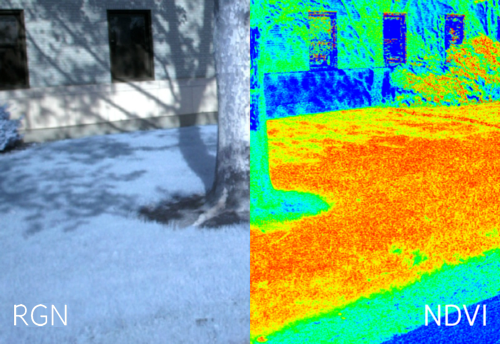](/i/45468?s=o) **** ## NRG imagery Some people are also interested in producing NRG imagery (like the below image), where `Near-Infrared, Red, and Green` are used to compose a picture instead of the usual `Red, Green, and Blue`. [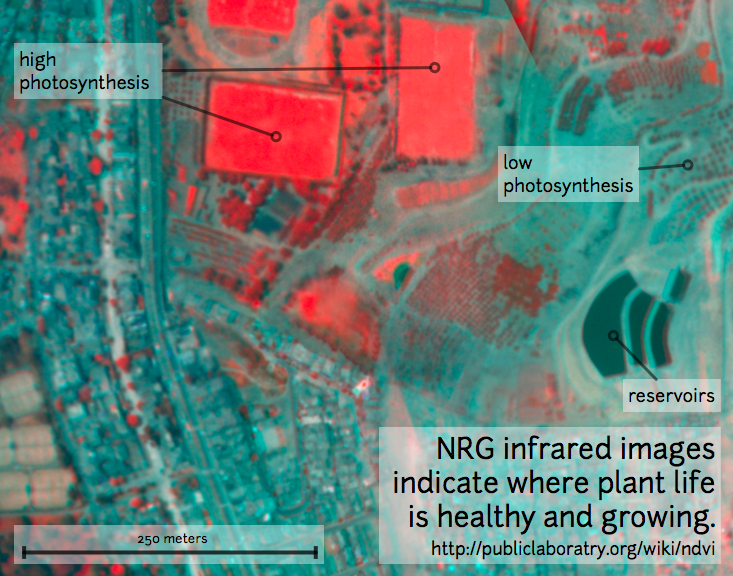](/i/25064) This diagram explains the swapping, which allows us to 'see' infrared as if it were a normal color: [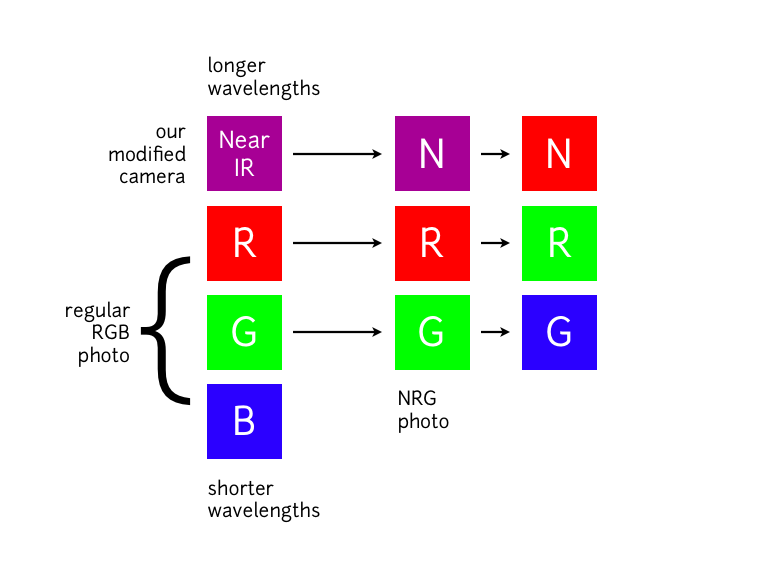](/i/25063) **In NRG images, the deeper and clearer the red color, the denser and healthier the vegetation (more or less).** ### Questions [questions:ndvi] ### Other examples of DIY NDVI imaging From around the internet: Begin watching at 2 minutes to see the resulting imagery: *This topic is part of the [Grassroots Mapping Curriculum](/wiki/mapping-curriculum) series.* **** [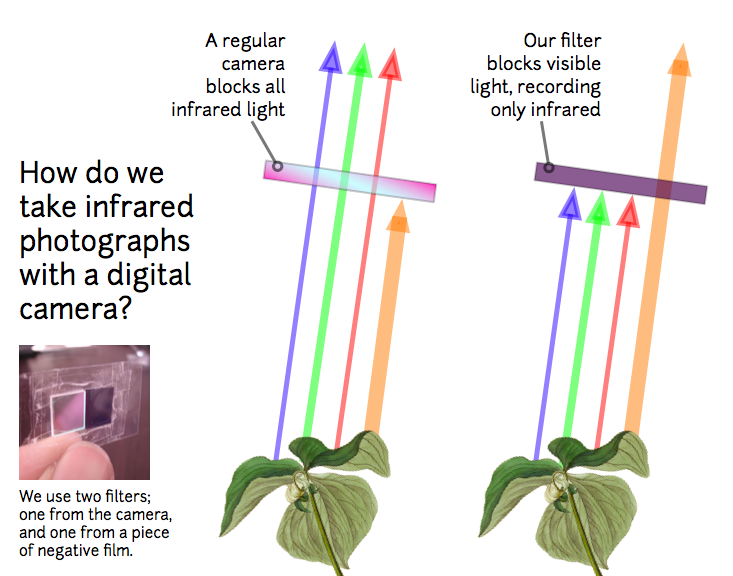](/i/25066) [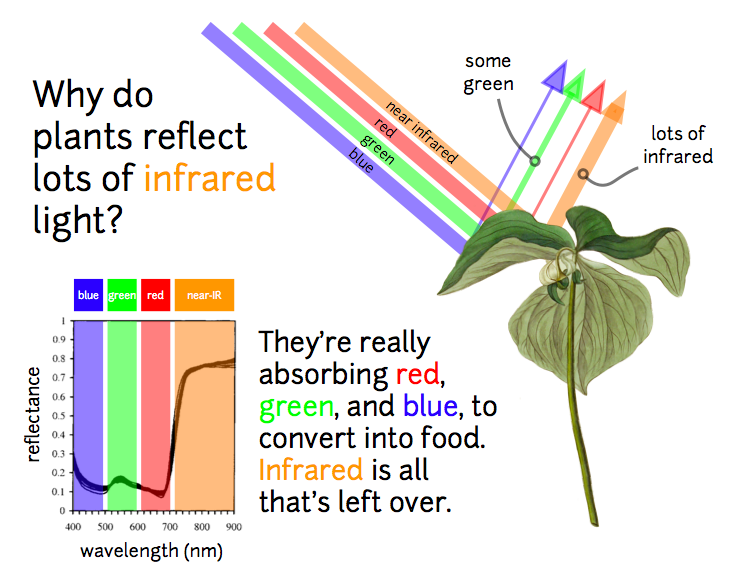](/i/25065) ...
| Author | Comment | Last activity | Moderation | ||
|---|---|---|---|---|---|
| PeeBee | "Thanks cfasie. I understand now the exposure issue you raise. But you seem to assume the different exposures are an unknown, which it strikes me ..." | Read more » | almost 11 years ago | |||
| cfastie | "To compute NDVI, you have to know the relative amount of light in a visible and an NIR band being reflected from plant leaves. The difference betwe..." | Read more » | almost 11 years ago | |||
| air_maiden | "I too am interested to see whether a non-modified camera and a camera with the IR filter removed can be used to calculate NDVI. Could you please cl..." | Read more » | almost 11 years ago | |||
| cfastie | "That's a really clever idea, and I think it might work. However, it assumes that: The photos must be simultaneous if anything in the scene is cha..." | Read more » | almost 11 years ago | |||
| PeeBee | "Thanks cfastie. I don't think I understand the need for the Wratten filter. My understanding is: A camera with just the IR filter removed (i.e. n..." | Read more » | almost 11 years ago | |||
| zorn | "Ah, thanks for the answers! Makes it much clearer now.... As i told before, i want to have the possibility to tae normal Pics and pure NIR.... I ..." | Read more » | almost 11 years ago | |||
| cfastie | "I see what you mean when you say that the difference between the blue and red channels is correlated with the presence of plants. Your monochrome i..." | Read more » | almost 11 years ago | |||
| cfastie | "Zorn, If you remove the IR block filter, the camera will take very strange photos because all three color channels (RGB) will have lots of NIR ligh..." | Read more » | almost 11 years ago | |||
| warren | "In short, while you've clearly shown there is IR in all 3 channels, there is still a reasonably good signal/noise ratio difference between 2 channe..." | Read more » | almost 11 years ago | |||
| warren | "Thanks Chris, but I'm not sure I agree that we're just seeing brightness due to infrared. I'm not saying this is NDVI -- it seems to work in the re..." | Read more » | almost 11 years ago | |||
| cfastie | "If you have two cameras, and your goal is NDVI or false color infrared, the best way to get what you need is one unmodified camera and one with the..." | Read more » | almost 11 years ago | |||
| PeeBee | "I am new to this field, and am busy trying to mod a Mobius by removing the IR filter and adding a blue (red remove) filter. I have made a side by ..." | Read more » | almost 11 years ago | |||
| cfastie | "More tests are definitely merited. First, I was assuming that Carl was using a Rosco blue filter, and my original conclusions were based on that. ..." | Read more » | almost 11 years ago | |||
| warren | "With the new Infragram.org, Mathew Lippincott and I did a new attempt at using these images and exploring the Mobius as a potential Infragram-modda..." | Read more » | almost 11 years ago | |||
| warren | "Hey just bumping this back up -- using Infragram.org Mathew L and I did a quick re-try on this, using the expression ((R-B)/(R+B))*-1 in the Hue fo..." | Read more » | almost 11 years ago | |||
| zorn | "Wrote a comment, but it does not show up. damn. once again! Thanks a lot for the instructions! My question is: if i remove the internal filter, c..." | Read more » | almost 11 years ago | |||
| zorn | "Thanks for the instructions, after reading this i punchraised a mobius from ebay, hopefully not a fake ^^ English is not my mothers tongue, so i h..." | Read more » | almost 11 years ago | |||
| Albertazzi | "Hi Chris, here: http://hal.archives-ouvertes.fr/docs/00/64/84/39/PDF/mo2011-pub00034131.pdf they explain very well how they take all the data. The..." | Read more » | almost 11 years ago | |||
| cfastie | "There is not much easily accessible information in that paper, but maybe what they did is this: They removed the IR blocking filter from a camera,..." | Read more » | almost 11 years ago | |||
| ecta64 | "thank you very much for posting those sources. I will take a look at them. I appreciate the help. " | | almost 11 years ago | |||
| cfastie | "These seem to be rather obscure indices that have very specific uses. Because satellite data always includes an NIR band, and because NIR provides ..." | | almost 11 years ago | |||
| ecta64 | "that's exactly the information I was looking for. It made sense for a fake infrared photograph to not be ideal for a proper index but at least now ..." | | almost 11 years ago | |||
| cfastie | "The Infragram Sandbox allows several different types of analysis, so it's hard to evaluate your image above without knowing what analysis produced ..." | | almost 11 years ago | |||
| bjornbrooks | "Cool. No doubt as you know NDVI is equivalent to (NIR - Red) / (NIR+Red), where Red is the 0.6-0.7 micrometer band and and NIR is the 0.7-1.1 micro..." | | almost 11 years ago |